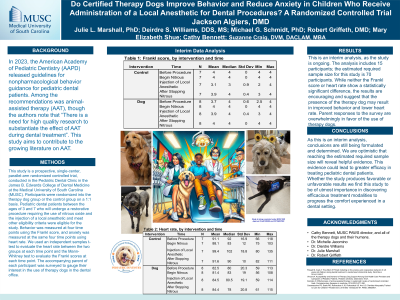Patient Management
419 - Certified Therapy Dogs Affect on Behavior During Dental Appointments


Jackson Algiers, DMD
Resident
Medical University of South Carolina
Medical University of South Carolina
Charleston, South Carolina, United States- DW
Deirdre S. Williams, DDS, MS
Associate Professor
Medical University of South Carolina
James B. Edwards College of Dental Medicine Medical University of South Carolina
Charleston, South Carolina, United States - HR
Hannah Rustin, DMD
Assistant Professor
Medical University of South Carolina
Charleston, South Carolina, United States
Presenting Author(s)
Research Mentor(s)
Program Director(s)
Title: Do Certified Therapy Dogs Improve Behavior and Reduce Anxiety in Children Who Receive Administration of a Local Anesthetic for Dental Procedures? A Randomized Controlled Trial
Principal Investigator: Julie L. Marshall, PhD
Abstract:
Purpose: This randomized controlled trial aims to evaluate the effectiveness of certified therapy dogs in reducing anxiety and improving behavior in pediatric dental patients aged 3-7 during procedures requiring local anesthetic injections. The study hypothesizes that the presence of a therapy dog will improve behavior and reduce anxiety, as measured by the Frankl scale, heart rate, oxygen saturation, and nitrous oxide usage.
Methods: Seventy children will be enrolled and randomized into two groups: a control group receiving standard care and an intervention group with a therapy dog present during the procedure. Parental perceptions will be assessed through brief surveys, and microbial concentrations in the dental operatory will be measured to address hygiene concerns.
Results: The primary endpoints include behavior ratings, physiological measures, and parental feedback. The study will compare these outcomes between the control and intervention groups to determine the impact of therapy dogs on pediatric dental patients' anxiety and behavior. Additionally, the presence of therapy dogs did not result in higher bacterial loads in the operatories.
Conclusions: The findings could provide valuable insights into non-pharmacologic behavior management techniques in pediatric dentistry, potentially reducing the need for sedation and improving overall patient experiences. If successful, this approach may encourage broader adoption of therapy dogs in clinical settings, enhancing care for pediatric dental patients.
Identify Supporting Agency and Grant Number:

.jpg)